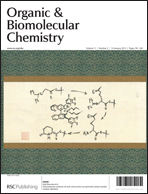With the aid of density functional theory (DFT) calculations, we have performed a detailed mechanism study for the catalytic cycloisomerization reactions of propargylic 3-indoleacetate to better understand the observed divergent reactivities of two catalysts, PtCl2 and (PPh3)AuSbF6, which result in [3 + 2]- and [2 + 2]-cycloaddition products, respectively. The calculated results confirm that the lactone intermediates are common and necessary species for the formation of the two products and that PtCl2 and (PH3)AuSbF6 respectively favor the formation of the [3 + 2]- and [2 + 2]-products. The intrinsic reasons for the divergent reactivities of the two catalysts have been analyzed in detail. We believe that the essentially different metal–ligand interactions in PtCl2 and (PPh3)AuSbF6 are mainly responsible for their divergent regioselectivities, while the solvent effects have little impact on the catalyst activity. Starting from lactone intermediates, PtCl2 induces the intramolecular nucleophilic addition to give the [3 + 2] cycloisomerization product due to the strong π-electron-donating ability of chlorine ligands, while (PPh3)AuSbF6 results in the intramolecular nucleophilic addition reaction to form the [2 + 2] cycloisomerization product because of the strong σ-electron-donating ability of phosphine ligands.
![Graphical abstract: Theoretical investigation on Pt(ii)- and Au(i)-mediated cycloisomerizations of propargylic 3-indoleacetate: [3 + 2]- versus [2 + 2]-cycloaddition products](/en/Image/Get?imageInfo.ImageType=GA&imageInfo.ImageIdentifier.ManuscriptID=C2OB26691A&imageInfo.ImageIdentifier.Year=2013)
You have access to this article
 Please wait while we load your content...
Something went wrong. Try again?
Please wait while we load your content...
Something went wrong. Try again?
![Graphical abstract: Theoretical investigation on Pt(ii)- and Au(i)-mediated cycloisomerizations of propargylic 3-indoleacetate: [3 + 2]- versus [2 + 2]-cycloaddition products](/en/Image/Get?imageInfo.ImageType=GA&imageInfo.ImageIdentifier.ManuscriptID=C2OB26691A&imageInfo.ImageIdentifier.Year=2013)

 Please wait while we load your content...
Please wait while we load your content...